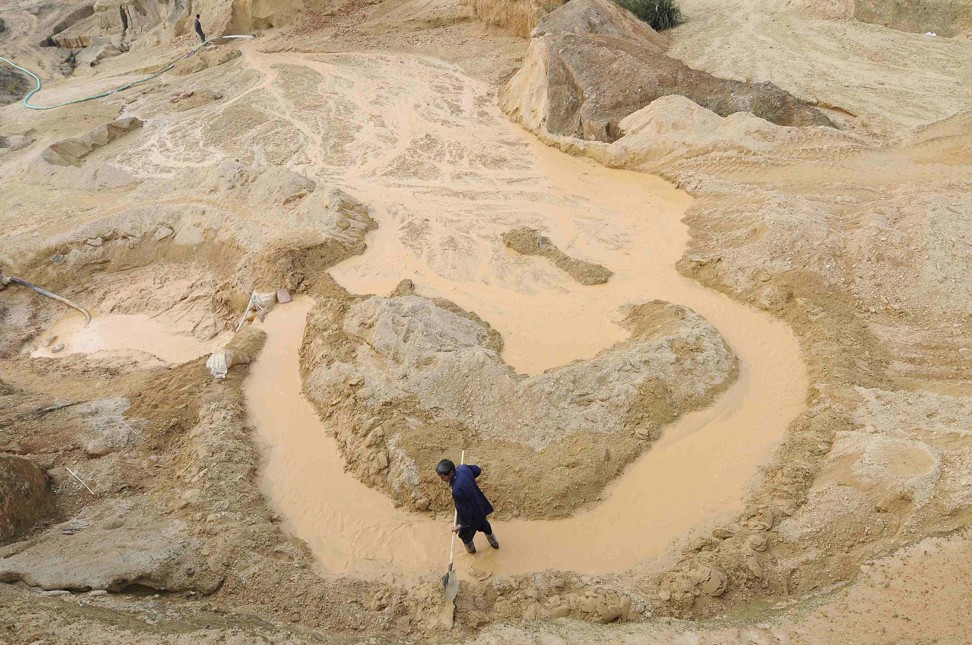
Explainer | Explainer: Used from iPhones to guided missiles, does China’s dominance in rare earths hold potential leverage in trade war?
- The little known minerals are used in a variety of industries and hi-tech devices
- China has accounted for more than 90 per cent of global production since the late 1990s
Rare earth elements could be a point of leverage that China may deploy against the United States as a trade war between the world’s two largest economies escalates, particularly after Chinese President Xi Jinping visited a production facility this week.
What are rare earths?
Rare earth materials are a group of 17 elements on the periodic table: cerium (Ce), dysprosium (Dy), erbium (Er), europium (Eu), gadolinium (Gd), holmium (Ho), lanthanum (La), lutetium (Lu), neodymium (Nd), praseodymium (Pr), promethium (Pm), samarium (Sm), scandium (Sc), terbium (Tb), thulium (Tm), ytterbium (Yb), and yttrium (Y).
What make rare earths rare?
Rare earths are actually more plentiful in the earth’s crust than precious metals such as gold and platinum, but they are “rare” because they usually exist in nature as compounds fused with other metals. Refining and extracting them in commercially viable quantities are expensive endeavours, especially in jurisdictions with strict environmental and effluent standards. That makes them scarce, and therefore rare.

Where are rare earths found?
Rare earth deposits exist in China, California, Australia, Brazil, Burundi, India, Malaysia, Myanmar, Russia, Thailand and Vietnam, with global deposit reserves estimated at 120 million tonnes.
The US was the world’s largest producer of rare earths for decades, until the 1980s. Since the Chinese government undertook a concerted effort to exploit the country’s reserves of rare earths – mined and processed in Inner Mongolia, Jiangxi, Shandong, Sichuan, Guangdong, Fujian, Hunan, Yunnan and Guangxi – China has accounted for more than 90 per cent of the world’s production, according to the US Geological Survey.
Last year, China mined about 120,000 tonnes of rare earth elements, or about 71 per cent of global output, following an increase in production in the US, according to the Geological Survey.
How are rare earths used?
The glass industry is one of the largest consumers of rare earths, where the compounds of cerium, lanthanum and lutetium are used in polishing, and as additives to provide colour or add special optical properties.
Permanent magnets are the next big category where rare earths are used. Neodymium iron boron (NdFeB, or “Neo”) magnets are the most widely used and strongest variety that is commercially available. They are found in hard disc drives, miniature motors, loudspeakers and headphones, smartphone speakers, electric turbines and generators.
Dysprosium, gadolinium and praseodymium are also used in magnets.
Yttrium, cerium, lanthanum, europium and terbium are used to manufacture cathode ray tubes and flat panel display screens.
Raytheon’s Patriot Missile air defence system uses radio frequency circulators to magnetically control the flow of electronic signals in radar and missiles. The rare earths used are gadolinium, samarium and yttrium.
Rare earth elements also are found in synthetic gems used in lasers, microwave equipment and superconductors.
What is the relationship between the US and China in rare earths?
The Mountain Pass mine in California is the only US producer of rare earths. It closed in 2015 after its operator went bankrupt and was sold to an American consortium backed by China’s Shenghe Resources Holding two years later. It resumed production last year and ships its production to China for refining.
China also is, by far, the largest exporter to the US, the source of 59 per cent of the US$155 million in rare earths that America imported last year, according to the US International Trade Commission’s data.
“Concerns about the availability of rare-earth supplies have stimulated efforts in recycling, substitution, and improving material efficiencies,” the Geological Survey said in its report. “These efforts are being led by the leading consumers” of rare earth elements, the agency said.
Has China ever used the country’s dominance in rare earths to its advantage?
In 2010, a diplomatic row ensued after a Chinese fishing trawler collided with Japanese coastguard patrol boats near the disputed Diaoyu island, known as the Senkaku in Japan. China reduced the export quota of rare earths, upon which Japanese carmakers like Toyota Motor Corporation and battery makers like Matsushita Electric’s Panasonic unit depend for their electric vehicles and battery packs.
Japan has been seeking alternative sources since the 2010 row. Around the same time, China attempted to restrict the supply of rare earths through quotas, licenses and taxes, according to the Geological Survey. Those restrictions were removed in 2014, but have fuelled an increase of stockpiling of the materials and exploration efforts outside China.
Japanese scientists indicated last year that they had discovered a concentrated cache of rare earth minerals on the seabed off the country’s coast.
Is China a net importer of rare earths?
By tonnage, China imported more rare earth elements in 2018 and the first quarter of 2019 than it exported, as the US and Myanmar increased their exports of the metals. On a yuan basis, China, however, exported much more than it imported because it is the world’s biggest refiner of rare earths. The only operating mine in the US sends all of its raw material to China to be refined into higher valuable, usable forms.

